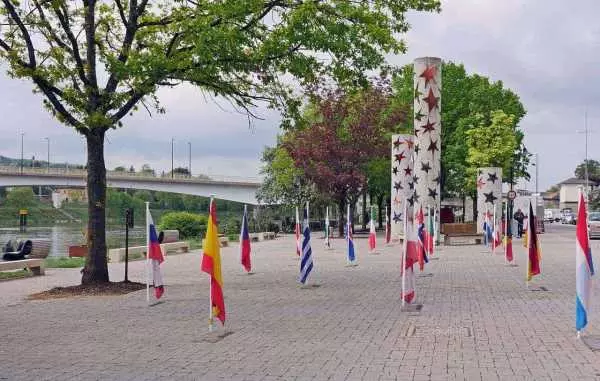Next Тренируйте память с помощью слов и цифр  Previous
Previous

Do you like the stuff? We will be grateful for the reposts.
 Previous
Previous
Puzzles or logics games are a board game whose purpose is to correctly understand how to form a union of parts of a certain image that are in different pieces or flat pieces.
The first puzzle was created almost by accident by John Spilsbury in 1760, a card design expert. He did this by placing one of the many maps he created on a hardwood board, cutting it off along the borders of countries.
This creation was used in Britain as a training lesson, originally for teaching children geography. The idea of its exclusive use in training lasted until approximately 1820 g.
Around 1900 riddles of an artistic nature were born, which were intended not for children, but for adults. These puzzles were wooden, carved by improvised means, they quickly became one of the favorite entertainments of high society.
These unique and stylish hobbies usually dazzled visitors who, thanks to their original beauty and unusualness, became a share of home heritage and customs. These hand-made puzzles had a peculiar style called “push-fit”, push-place, because of how they should be assembled : Following the cut, the contours of the image and the color areas, pieces lacking a pen, they did not assemble each other, as in modern commercial puzzles, but rather connected each other in the most subtle way. Thus, the pickers had to be very careful, as sudden movement or even sneezing could disrupt the patient's work all day.
Artistic puzzles for adults, unlike children, did not include an image that guided the assembler, who should be content with a suggestive heading, before sitting down to solve the riddle behind which the artisan hid the picture.
This was one of his incentives and main attractions: gradually revealing, step by step creating a hidden work of art, a work of art, which, as soon as the mystery is solved, we will pay close attention, which will make us know while its most hidden details.
The puzzles of 1900, in which parts, and not connected together, were located next to each other, became a real test and a fascinating hobby.
Currently, they are still most appreciated by those for whom elegance, complexity and sophistication are the main incentive that prolongs the pleasure of restoring and discovering a hidden image.
In the first decade of the twentieth century, a well-known American toy manufacturer decided to devote his entire production to puzzles from wood craftsmen and presented very interesting variations for the public: figurative objects and pens.
The handles made it possible to assemble the pieces together, which made it difficult to easily disassemble the puzzle, and allowed the parts to take new forms. Figurative figures, silhouettes of animals, people or recognizable objects aroused great admiration and surprise among fans; They not only emphasized the skill and imagination of the cutting tool, but also added puzzles and exclusivity to the game, which has already risen to the category of artwork.
The experiments and the creation of new forms of artistic cut did not stop throughout the twentieth century, and the best artisans presented such novelties as uneven edges, false corners and various ways to challenge fans even more.
However, although several artisans have developed and maintained the tradition of handmade wooden jigsaw puzzles for adults, it is a hobby that retains all the flavor of other times.
In 1762 Londoner John Spilsbury made the first almost by accident. Spilsbury attached one of his cards to a panel of hardwood, cutting it according to the borders of the countries with a saw. Thus, the history of modern puzzle began by chance. The end product, new at the time and initially expensive to manufacture, has gradually become a popular educational hobby designed as a teaching tool for teaching geography to British students. A century later, Milton and McLaughlin Bradley began to produce them in series.
The puzzle or puzzle, which is difficult to solve, is also called the puzzle; as well as some types of crosswords.
For the area, the puzzle is any problem that arises, the solution of which is based solely on the resolution of the skill test. In the same area the puzzle also consists in combining various intermediate goals during the game, which may belong to another category, such as adventure, strategy, action or role-playing. Example: Professor Leighton and the mysterious villa.
The first puzzles
The first puzzle was created almost by accident by John Spilsbury in 1760, a card design expert. He did this by placing one of the many maps he created on a hardwood board, cutting it off along the borders of countries.
This creation was used in Britain as a training lesson, originally for teaching children geography. The idea of its exclusive use in training lasted until approximately 1820 g.
The riddles of 1900
Around 1900 riddles of an artistic nature were born, which were intended not for children, but for adults. These puzzles were wooden, carved by improvised means, they quickly became one of the favorite entertainments of high society.
These unique and stylish hobbies usually dazzled visitors who, thanks to their original beauty and unusualness, became a share of home heritage and customs. These hand-made puzzles had a peculiar style called “push-fit”, push-place, because of how they should be assembled : Following the cut, the contours of the image and the color areas, pieces lacking a pen, they did not assemble each other, as in modern commercial puzzles, but rather connected each other in the most subtle way. Thus, the pickers had to be very careful, as sudden movement or even sneezing could disrupt the patient's work all day.
Artistic puzzles for adults, unlike children, did not include an image that guided the assembler, who should be content with a suggestive heading, before sitting down to solve the riddle behind which the artisan hid the picture.
This was one of his incentives and main attractions: gradually revealing, step by step creating a hidden work of art, a work of art, which, as soon as the mystery is solved, we will pay close attention, which will make us know while its most hidden details.
The puzzles of 1900, in which parts, and not connected together, were located next to each other, became a real test and a fascinating hobby.
Currently, they are still most appreciated by those for whom elegance, complexity and sophistication are the main incentive that prolongs the pleasure of restoring and discovering a hidden image.
In the first decade of the twentieth century, a well-known American toy manufacturer decided to devote his entire production to puzzles from wood craftsmen and presented very interesting variations for the public: figurative objects and pens.
The handles made it possible to assemble the pieces together, which made it difficult to easily disassemble the puzzle, and allowed the parts to take new forms. Figurative figures, silhouettes of animals, people or recognizable objects aroused great admiration and surprise among fans; They not only emphasized the skill and imagination of the cutting tool, but also added puzzles and exclusivity to the game, which has already risen to the category of artwork.
The experiments and the creation of new forms of artistic cut did not stop throughout the twentieth century, and the best artisans presented such novelties as uneven edges, false corners and various ways to challenge fans even more.
However, although several artisans have developed and maintained the tradition of handmade wooden jigsaw puzzles for adults, it is a hobby that retains all the flavor of other times.
Modern puzzles
In 1762 Londoner John Spilsbury made the first almost by accident. Spilsbury attached one of his cards to a panel of hardwood, cutting it according to the borders of the countries with a saw. Thus, the history of modern puzzle began by chance. The end product, new at the time and initially expensive to manufacture, has gradually become a popular educational hobby designed as a teaching tool for teaching geography to British students. A century later, Milton and McLaughlin Bradley began to produce them in series.
The puzzle or puzzle, which is difficult to solve, is also called the puzzle; as well as some types of crosswords.
Video games
For the area, the puzzle is any problem that arises, the solution of which is based solely on the resolution of the skill test. In the same area the puzzle also consists in combining various intermediate goals during the game, which may belong to another category, such as adventure, strategy, action or role-playing. Example: Professor Leighton and the mysterious villa.
Do you like the stuff? We will be grateful for the reposts.
Comments:
Be the first to comment on the article!
Interesting facts (Collapse) |
|---|
| |
Петро Полюхович © 2011-2024
Join us if you are a true crossword puzzler!


 Login
Login Crosswords
Crosswords Conundrums
Conundrums Sudoku
Sudoku English
English Turkish
Turkish About
About
